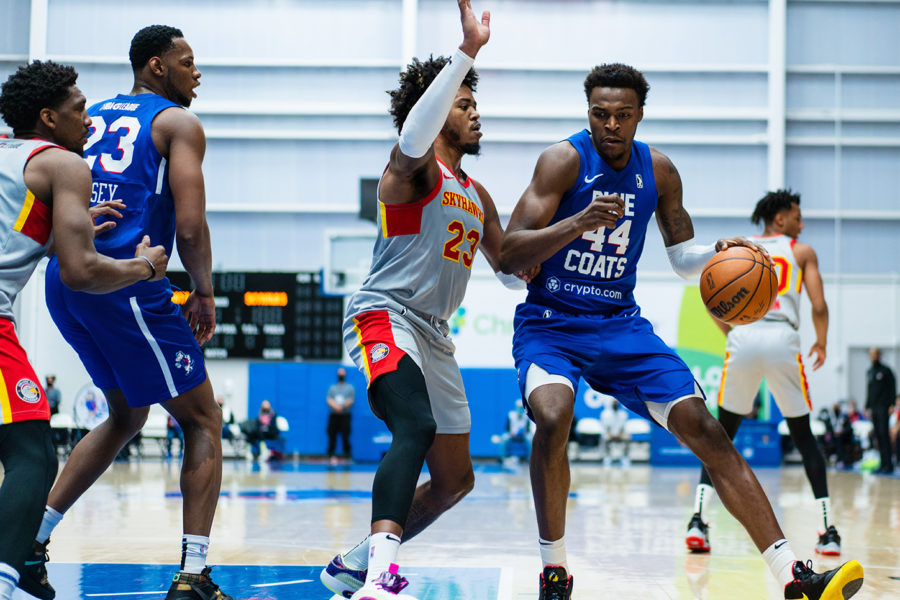
WILMINGTON, DE - JANUARY 28: Paul Reed #44 of the Delaware Blue Coats handles the ball against the College Park Skyhawks on January 28, 2022 at Chase Fieldhouse in Wilmington, Delaware. NOTE TO USER: User expressly acknowledges and agrees that, by downloading and/or using this Photograph, user is consenting to the terms and conditions of the Getty Images License Agreement. Mandatory Copyright Notice: Copyright 2022 NBAE (Photo by Mary Kate Ridgway/NBAE via Getty Images)
Questions immediately arose when the Sixers made yet another second-round departure from the NBA Playoffs this spring. How can they improve their roster? Should they sign James Harden to a max contract? Can Joel Embiid ever play healthy in the postseason? As the summer unfolds, the actions of Daryl Morey will answer some of these questions. Unfortunately, Morey has little wiggle room. The Sixers are currently over the league salary cap. Because of that, they can only sign outside players using their available mid-level exception, worth $6.4 million, and the trade exception the team received when they traded Andre Drummond to Brooklyn in February. That slot is worth $1.7 million. In addition to having little money to sign players, they also have only two available roster spots.
Barring a trade or trades, both of which seem unlikely, the only way the Sixers can show marked improvement is with a healthy Harden and reaping dividends on their G-league investments.
As part of the Sixers’ regular rotation, Paul Reed, Jaden Springer, and Charles Bassey are names you will likely hear next season. Reed was the Sixers’ 2nd round selection in 2020 out of DePaul. He earned MVP of the G-league in his rookie season, a season spent in “the bubble.” He played nine games for the Delaware Blue Coats this past season, averaging 22 points, 13.5 rebounds, and 1.8 blocks. He shot 57 percent from the field and 43 percent from the three-point range.
Additionally, he appeared in 38 NBA games but averaged just eight minutes. However, when the postseason began, it became apparent that neither Paul Millsap nor DeAndre Jordan was a capable backup center at this stage of their careers. The young, athletic, yet under-sized Reed was a better option. He appeared in 12 playoff games and averaged 11.6 minutes, four points, and four rebounds.
“I think he plays bigger than his size,” Coby Karl said, having coached Reed in those nine G-league games. “He can get loose balls and offensive rebounds. He has a high activity level and high motor. Those things allow him to play that position even though sometimes he is physically outmatched. He has an elite level of focus; he can compete, and he wants to be great.
“I think he has taken a step in understanding who he must be to fit in the NBA. He showed that he could be a consistent role player and be relied on in pressure situations. The next step is to display some of the skills that earned him the MVP. He can dominate a game for a five-minute segment defensively, offensively, energy, physically – all those things. I think you will see those things in the upcoming year.”
Charles Bassey is another promising big man under contract with the Sixers. The Western Kentucky product is 6’10 and was selected 53rd overall last spring. He appeared in 17 games for the Blue Coats this year, averaging 19 points, 10.3 rebounds, and 3.4 blocks.
“It is nice to have them both in our program for our organization,” Karl stressed. “They want to be great. They have ambition. They have a work ethic that will allow them to get better. It might be like the righty-lefty thing in baseball. Do you need the bigger guy? Or do you need the agile guy?”
Going from being a G-league player to a significant NBA contributor is happening more and more. Last year the Warriors’ Jordan Poole, the 28th overall pick in 2019, started 11 games in the bubble for the Santa Cruz Warriors. He averaged 22 points. He played 76 regular-season games for the NBA Warriors a year later, making 51 starts and averaging 18.5 points.
“The routine used to be sink or swim. When you get your opportunity, you play well, or you don’t,” Karl explained. “I think it is easier utilizing the G-league, and you see the benefit. These guys might not know how to play in the NBA right now. They have the skills to play, they just need to learn how to play. They need to build confidence and find their rhythm. Organizations are investing more in their talented players, their higher draft picks because they see the benefits of sending a player like Jordan Poole down. He is talented enough; he just needs to learn how to play this game a little better.”
The evidence suggests Poole was a fast learner.
The NBA started its developmental league in 2001. They had eight teams initially. Today 29 of the NBA teams have a development squad, with Portland being the lone team without a G-league affiliate. Over the last two decades, the G-league product has improved as the talent increased.
“I can go to Belgium and make $100K or play in the G-league and make $85K,” Karl shared. “From when I was a player, no one wanted to go to Europe and play. We all dream of playing in the NBA playoffs; we dream of playing at Madison Square Garden.
“Because the line is so much closer now, you see some of our better talents decide to invest a year or two early on in the G-league because the money is marginal. A player says, ‘I’ll take that chance,’ because of how great the chance to get that call-up is. I think of the success of the players who led the way early on: Danny Green, Jeremy Lin, Alex Caruso. It is easier when you see it, and now you can believe it.”

